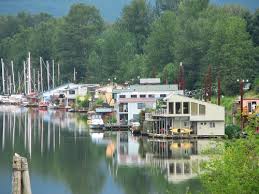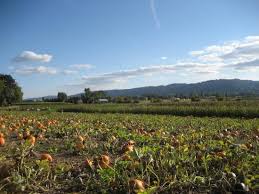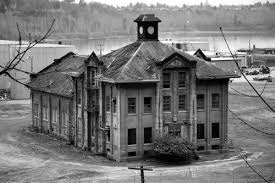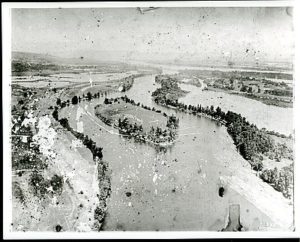Linnton Neighborhood is right along the Columbia River as you head out towards Scappoose and the coast, just past the St John’s Bridge that leads to St Johns neighborhood in N Portland.

A collage giving a snapshot of what Linnton Oregon is like
It’s just a little town- only 10 minutes from Portland- just past the St. John’s Bridge. Sauvie’s Island is right by it. If you like the farmland and the river- you will probably like it here- although housing prices are going up quickly because everyone wants to be in the city but also in the country, but it is still very reasonable compared to the rest of NW and N Portland. This is because most of Linnton Neighborhood is close to industrial or over looking the industrial areas of the Willamette and Columbia Slew. It is very noisy because of the trucks and trains and other noise that goes along with the heavy industry that is still being conducted there. But if you go up the hill a little big, there are some little streets up there with houses that have an amazing view of the River and the mountains. And they are just far enough away, that the noise isn’t too loud!
 Linnton Neighborhood location is in some ways very special, because it borders Sauvie’s Island which is an almost untouched huge island made by the Columbia River, the Slough and the Willamette Rivers. It is mostly farmland, lots of beaches, quiet country roads people love to bike on. There are some houseboats docked here on the island, which must be a very special life! You also have Forest Park that goes up the hill behind you, and you can access the trails from the neighborhood. Parts of it have amazing views….but you have to weigh these positive things with the negative. The negative being that it has been the industrial hub for so many past years, that there is toxic waste all around it. There are huge oil drums that aren’t earthquake proof, which would explode and catch fire if we had an earthquake, the land, beaches and the silt are full of toxic materials. Here is a good photo discussion as to what has happened during Linnton’s history, and what they have to overcome to clean it up.
Linnton Neighborhood location is in some ways very special, because it borders Sauvie’s Island which is an almost untouched huge island made by the Columbia River, the Slough and the Willamette Rivers. It is mostly farmland, lots of beaches, quiet country roads people love to bike on. There are some houseboats docked here on the island, which must be a very special life! You also have Forest Park that goes up the hill behind you, and you can access the trails from the neighborhood. Parts of it have amazing views….but you have to weigh these positive things with the negative. The negative being that it has been the industrial hub for so many past years, that there is toxic waste all around it. There are huge oil drums that aren’t earthquake proof, which would explode and catch fire if we had an earthquake, the land, beaches and the silt are full of toxic materials. Here is a good photo discussion as to what has happened during Linnton’s history, and what they have to overcome to clean it up.
Homes vary in style from modern architecture, to classic Bungalow, to Old Portland, to Cape Cod, Four Square and even little cottages. Some houses have acreage, some are on regular sized lots. The Linnton neighborhood feels like a mix of rural, suburban neighborhoods that are tucked into the trees and hillside. They follow Forest Park to the West and Hwy 30 to the east. Forest Park is definitely the highlight of this neighborhood. Forest Park is a spectacular 5000 acre Park that goes for 8 miles out along the hill that overlooks the Willamette River and it’s main trail, the Wildwood, is over 30 miles long! There is all kinds of other trails and tons of wildlife, including the little pigmy owl that they have been showing on PBS! It is a spectacular forest in the city! You feel like you are way out, up in the mountains.
have acreage, some are on regular sized lots. The Linnton neighborhood feels like a mix of rural, suburban neighborhoods that are tucked into the trees and hillside. They follow Forest Park to the West and Hwy 30 to the east. Forest Park is definitely the highlight of this neighborhood. Forest Park is a spectacular 5000 acre Park that goes for 8 miles out along the hill that overlooks the Willamette River and it’s main trail, the Wildwood, is over 30 miles long! There is all kinds of other trails and tons of wildlife, including the little pigmy owl that they have been showing on PBS! It is a spectacular forest in the city! You feel like you are way out, up in the mountains.
 The nice thing about this location is it is minutes from NW 23rd, the cute little town of St Johns and Sauvie’s Island. Sauvie’s Island has sprawling farmland, which is great for local produce, and some great beaches along the Columbia River. And the Columbia Slough is amazing. We used to take our boat out on it and go to St Helens. It was almost like you are out in some jungle river, somewhere way out away from everything. It is pretty much untouched. There is one really good restaurant with a dock you can pull up to, which we would stop and eat at each time, and then go on to St Helens. St Helens is a pretty cool place from the river- Sauvie’s Island creates the slough, and it separates the full raging Columbia from the quiet, peaceful slough.
The nice thing about this location is it is minutes from NW 23rd, the cute little town of St Johns and Sauvie’s Island. Sauvie’s Island has sprawling farmland, which is great for local produce, and some great beaches along the Columbia River. And the Columbia Slough is amazing. We used to take our boat out on it and go to St Helens. It was almost like you are out in some jungle river, somewhere way out away from everything. It is pretty much untouched. There is one really good restaurant with a dock you can pull up to, which we would stop and eat at each time, and then go on to St Helens. St Helens is a pretty cool place from the river- Sauvie’s Island creates the slough, and it separates the full raging Columbia from the quiet, peaceful slough.
History of Linnton Neighborhood
I found this history on the Linnton Neighborhood Website. They have alot of information there, and it seems that at one time it was a bustling town! Here is what I found:
1843 – Linnton was the landing site of the first Canestoga wagons to raft the Columbia, the spot selected by Morton McCarver and Peter Burnett. They named the place for a senator from Missouri, Lewis Linn, who authored land grant legislation to “keep Oregon out of the hands of the English.” They built a log road over the hill (now Springville Road), for the wagons to proceed on, and when their speculation in Linnton didn’t immediately produce the port city they were hoping for, hit the road themselves, Burnett to become the first governor of California, McCarver to  found Sacramento and Tacoma.
found Sacramento and Tacoma.
1844 – James John built a warehouse in Linnton. In 1846 he moved across the river. A visiting Navy lieutenant, Neil Howison, called Linnton “very poor, and persecuted by mosquitoes day and night,” with a future that was ”doubtful.”
1849 – The tent town, and its blacksmith shop, was substantially thinned when gold was discovered in the Sierra Nevada foothills.
1850 – Solomon Richards, given a 640 acre land claim in Linnton, sold lumber, cleared 50 acres for a dairy farm, and sold pieces of his land for the next 30 years, including the railroad right of way before moving to Portland in 1883. A rail line went through Linnton shortly thereafter.
In 1889 a smelter was proposed for Linnton, an excursion for investors to the site treated to a “great orchard of cherries” and a “huge patch of strawberries.” The smelter was built, but quickly went out of business. Linnton’s Post Office opened in 1989, sharing a building with Alcorn’s grocery. By the mid-1890’s Linnton had a small school, a boarding house and a little Methodist Church.
Just before the turn of the century a horse meat pickling and canning plant opened, using Indian ponies from Eastern Oregon described as “useless little brutes, consuming feed that ought to go to range cattle.” The meat was sold in England and to the English army in South Africa. There were lots of horses but profit was hard to come by and there were problems with rounding up ponies belonging to someone not an Indian. When a shipment of pickled horse bound for France arrived spoiled, the company went under.
 In 1904 Linnton’s first lumber mill was finished, built by the biggest lumber baron in the state, Robert Suitor, who sold it to Clark & Wilson and the little town was ready for lift off. Oil companies first showed interest in Linnton in 1902, several lumber mills were built, a ship building company shouldered up between mills and the town’s population went from about 400 to 2000 in 1914. A listing of larger companies with facilities in Linnton in 1913 includes:
In 1904 Linnton’s first lumber mill was finished, built by the biggest lumber baron in the state, Robert Suitor, who sold it to Clark & Wilson and the little town was ready for lift off. Oil companies first showed interest in Linnton in 1902, several lumber mills were built, a ship building company shouldered up between mills and the town’s population went from about 400 to 2000 in 1914. A listing of larger companies with facilities in Linnton in 1913 includes:
- Portland Gas & Coke
- Standard Oil
- Union Oil
- Monarch Oil
- S.C. Rasmussin & Sons
- Associated Oil
- Columbia Electrical (ship building)
- Clark-Wilson Lumber
- Willamette Box
- Columbia Creosoting
- West Oregon Lumber
- Consumers Lumber & Supply
- S. Ban Shingle Company
The vast majority of employment in Linnton Neighborhood was in the mills and most workers lived in company housing along the railroad tracks and were immigrants; Japanese, Filipino, Italians, East Indians, and Czechoslovakian, with different groups living in different parts of town. Linnton asked to be annexed into Portland in July of 1910 but was rejected. Three months later Linnton Neighborhood was incorporated as a city. Beginning in 1908 a trolley line was built from Portland to Linnton, as well as a stone breaking county jail at the Rock Pile, in the quarry. In 1911 City Hall was built with a fire station on the first floor. There was a bank, two schools, several churches and two newspapers in town. With the free ferry between, Linnton Neighborhood had close ties to St. John’s. The streets were being paved and by 1913 water from Bull Run had been piped in, and a sewage system installed. That next year there was electricity, sidewalks, telephones and there would soon be gas.
By 1911 the Linnton Road was very popular; 50 cars were counted in one day. It was dirt and gravel

historic gas and coke linnton
and very windy. There were a lot of accidents, mostly cars rolling down embankments, many people hurt, with a steady drumbeat of deaths. By 1922 615 cars were counted in one day headed to Astoria, the traffic good for Linnton businesses.
In the first decade of the new century, with alarming regularity, there were intense warehouse fires and explosions at oil companies on the east side of Portland. The large oil tanks next to the warehouses were spared through luck and the “almost superhuman efforts to the fire department,” although many buildings and businesses were lost. The Madison Street bridge was burned in one of several Standard Oil fires, along with a schooner being built next to the bridge. Warehouse owners and residents adjacent to the oil companies were up in arms, suits filed.
In June of 1911 the Union Oil facility at E. Water & Salmon Streets caught fire, including two large underground tanks. In the ensuing conflagration many small tanks exploded, one of which collapsed a wall onto the longtime fire chief, David Campbell, burning him to death. The next day Mayor Simon said, “I deem the maintenance to these tanks a serious menace to life and property. There is also great danger that the burning petroleum may flow into the Willamette River and destroy not only the bridges belonging to the city but the shipping in the harbor.” Two months later an ordinance, drawn up in secret by the insurance industry, was passed without dissent, and under suspension of the rules, making tanks acceptable in 5 districts of the city: Standard and Union Oil would have to move. There was a public outcry, the controversy lasting several months. In January of 1912 the city council passed an ordinance banning tanks of over 5000 gallons from the city. Two weeks later the new mayor, Rushlight, vetoed it. Two weeks after that the city council overturned the veto by a vote of 10 to 3.
In 1913 and 14 Linnton, a “suburb,” became a very popular place to locate large tanks, over $2 million (a lot of money then) spent on them in 1913 alone. In 1915 Linnton again voted to be annexed into Portland, and this time Portland approved. In 1917 most of the ordinance banning tanks was quietly eviscerated by the city, and in 1941 repealed entirely.
In 1933 Joseph Lemma set up a wine business in downtown Linnton, bottling from a tank car and selling in Portland. Unfortunately this was a singular bright spot in that decade. The prosperity Linnton enjoyed ended with the Depression, which hit hard. In conversations with Dick DiVincenzo and Walter Cole — that is, Darcelle — who were both children growing up in Linnton in the ‘30’s, it  was a pleasant, spirited and cohesive place to live, though poor. The community center was the town’s focal point for them. Mill workers chose to work three day weeks rather than have anyone laid off. Still, the Linnton of the teens and twenties didn’t return. The two largest mills burned down between 1945 and 1950, not to be rebuilt. Most of downtown was torn down for the St. Helens Road widening in the early ‘60’s. And here we are.
was a pleasant, spirited and cohesive place to live, though poor. The community center was the town’s focal point for them. Mill workers chose to work three day weeks rather than have anyone laid off. Still, the Linnton of the teens and twenties didn’t return. The two largest mills burned down between 1945 and 1950, not to be rebuilt. Most of downtown was torn down for the St. Helens Road widening in the early ‘60’s. And here we are.
Sauvie’s Island was also settled back in the late 1899s. It was always used for farmland, and still is!


